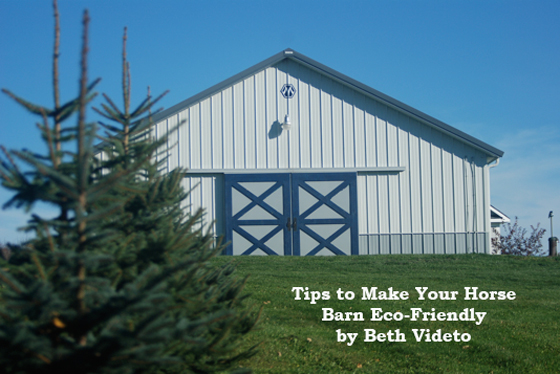Tips to Make Your Horse Barn Eco-Friendly
by Beth Videto

If you consider yourself a horse person you like animals, enjoy being outdoors, don’t mind getting down in the dirt and prefer the woods and fields, to skyscrapers and crowded streets. In short, you enjoy nature. If you are lucky enough to own your own horse you are likely familiar with the financial stresses caused by stretching each dollar to feed your largest child, whom eats close to twenty pounds of food daily. Given both of those things, the following are a few ideas, tricks and hints to either save a little money or save a little bit of the planet.
1.) A Fresh Coat of Paint: Light hued wall paints reflect light better, this means you can use less light bulbs and with lower wattage and still see just as well. As an addendum to this, it is also far more wallet friendly to change to compact fluorescent light bulbs from incandescent light bulbs. Twenty six watt, energy smart fluorescent light bulbs provide the same amount of illumination as one hundred watt incandescent bulbs, saving you money. Combine that with a light coat of paint to reflect the sunlight streaming through your windows during the day and you’re looking at a happier and brighter you.
2.) Motion Activated Flood Lighting: The sun is fantastic, but she’s only out during the day. So we turn to electricity to help us during our moon lit hours. Installing a motion activated light where you currently have ones that switch on and off manually will help save energy on those nights that you may have forgotten to turn the lights off. It will also keep you from falling flat on your face whilst getting to the light switch on those really dark, moonless nights. And if you are accident prone (like myself) you may want to consider lighting your walkways. Some genius out there came up with solar powered walkway lights that use no electricity. They are reasonably priced but be careful not to place them where a horse may tread.
3.) Insect control: You can get rid of flies and ants without harsh insecticides. A couple drops of dishwashing fluid in a small glass or a strung up plastic bag of apple cider vinegar will draw flies in and bring them to their ultimate demise. Or if you have an ant infestation, leave small piles of cornmeal near their ant hills. They will take the meal home for food for the colony, but ants cannot digest cornmeal and that will take care of your problem for you.
4.) Consider Rain Barrels. Decreasing your use municipal water sources is rarely thought about, but clean water is still a resource that not everyone has the privilege of enjoying. Rain barrels set up near drainage spouts can collect enough water to hydrate your grass and gardens as well as give you a bit of a buffer in cases of drought. Check your particular type of roof material and be certain that run-off from its type is safe to use for the purpose in which you plan to use it.
5.) Compost: It takes a bit of effort to set up but once you have done it, it’s just a few minutes out of your week to maintain. The most important part is ventilation and inner temperature. It needs to be warm enough to kill larvae and bacteria, but ventilated well enough that it is not too wet or too hot in the middle. Giving instruction on how to properly and safely compost your own horse manure is literally an article unto itself. But here is an extremely helpful link on how to compost your manure and give your field a boost of fertilization: http://whatcom.wsu.edu/ag/compost/horsecompost.htm
6.) Solar Water Heater: Heating water is far more energy consuming than most people realize. Solar hot water heating systems may run you a couple grand for your wash stall, but consider the fact that it will save you sixty to eighty percent of the money you are currently spending on heating water per year while reducing the carbon foot print of your farm; and it qualifies your farm for a special tax credit. So it may be something to think twice about.
7.) Green Roof: A “green roof” is a roof that you grow vegetation on, intentionally. I know this may sound extreme, but it reduces heating costs by twenty-five percent annually and cooling costs by an impressive 50% annually. This tactic has been used in parts of Europe for over thirty years. It also helps reduce the amount of heat reflecting off the planet which is adding to global warming.
8.) Avoid Chemical Cleaners: There are a few products most people have around the house that can be used to clean water buckets, troughs, grain bins etc. while still avoiding chemical cleaners. Baking soda in water combined with a scrub brush or a Greenie work very well. I will say that, the baking soda does not keep the algae away for very long but it is still chemical free. What will kill the bacteria that cause algae? I little bit of mouthwash. Mouthwash is a fantastic disinfectant. Vinegar when mixed with water 1:3 is a very good cleaner as well.


